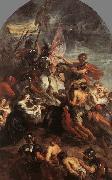Porslinet engros- Olja måleriet Engros- Måleriet Porslinet |
|||||||||||

|
|||||||||||
|
|
|
||||||||||||||
|
RUBENS, Pieter Pauwel
Flemish Baroque Era Painter, 1577-1640 |
||||||||||||||
|
|
||||||||||||||
|
||||||||||||||
|
|
||||||||||||||
| RUBENS, Pieter Pauwel
Flemish Baroque Era Painter, 1577-1640 1634-37 Oil on canvas, rounded at the top, 569 x 355 cm Musees Royaux des Beaux-Arts, Brussels This painting was commissioned in 1634 for the high altar of the Abbey of Affligem, then one of the most important monasteries in the Low Countries. Tensions inside the monastery may explain why this monumental work was not delivered until 1637. In this production of his mature period, Rubens masterfully combines two artistic traditions. The first of these is that of the large single-frame altarpieces that were to replace the older polyptychs in the Southern Low Countries in the 17th century. With their exceptional scale and their strongly vertical format, they faced artists with the problem of constructing a convincing compositional unity from a series of related themes in a vertical format. As an artist gifted with one of the greatest compositional and narrative talents of his age, Rubens fulfilled his task masterfully. Instead of dividing the painting into an upper and lower register, a solution that he had often applied following Titian, he elects here to represent Christ's ascension to the place of his execution on Calvary in an uninterrupted zigzag movement. The thrust from below to above is achieved both in the colouring, with a balanced rhythm of localised concentrations of colour, and also iconographically, with the successive tableaux of the executioners with the two thieves, the holy women with Mary and Veronica, and ending with the Roman officers on horseback with their flapping pennants. The centre-point of the composition is Christ's face that St Veronica is wiping. Turned towards the viewer, it forms a direct call to the faithful to follow his life and to think on their own sins that had to be redeemed by Christ's suffering. This procedure descends directly from the tradition of devotional art, with small-scale pictures intended for individual meditation. The genius of Rubens' invention lies precisely in the combination of the two pictorial traditions, breathing new life into the ancient devotional tradition within a contemporary, counter-reformation form of altar decoration, whilst at the same time enriching the broad, sweeping movement of such a monumental high altarpiece with the more intimate emotionality of smaller devotional paintings. , Artist: RUBENS, Pieter Pauwel , The Road to Calvary , 1601-1650 , Flemish , painting , religiou |
||||||||||||||
|
Related Paintings to RUBENS, Pieter Pauwel :. |
||||||||||||||
|
|
||||||||||||||
|
|
||||||||||||||
|
KOMMA I KONTAKT MED Oss |







